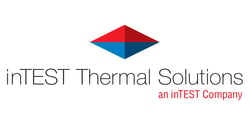Optical Transceiver Thermal Testing

The rapid pace of transceiver design and high volume production demands high efficiency for characterization and tuning. Thermally, it means that devices must reach their programmed temperatures quickly. The ThermoStream® achieves this by creating a stable environment in seconds.
Using Device-Under-Test (DUT) control, the ThermoStream can temperature cycle a device from ambient to -20°C in under 10 seconds. In this example, DUT control produces air at -40°C until the transceiver case approaches -20°C. Then the air temperature is automatically regulated to -20°C and holds to within 1°C.
Whether testing high volume transceivers with limited temperature cycling or more complex transceivers that need extensive tuning at temperature, there is a ThermoStream model to help you meet desired yields.
ThermoStreams provide:
- Mobility to generate cold temperatures without LN2 or LCO2
- Rapid temperature transition times, up to 40°C/sec.
Temperature accuracy and stability with DUT control
Frost elimination with dry-air purge
Used by the leading manufacturers of optical transceivers, ThermoStreams provide rapid temperature transitions with very precise temperature control.

Rapid thermal cycling from -80 to 225°C provides optimal throughput for transceiver characterization and tuning at temperature. (See DUT control below.)
DUT Control and Delta Temperature bring optical transceivers to temperature with speed and precision

Fig. 1. DUT control. The ThermoStream controller drives the environment to temperature based on reading a sensor affixed to the optical transceiver. Sensor types can be type T or K thermocouples, 100 Ohm RTD, or diode.

Fig. 2. DUT control example. Thermal cycling between 3 set points: ambient to 70°C; 70°C to 0°C, 0°C to 70°C with 5- minute soak times. Using DUT control, the ThermoStream overdrives the environment to reduce soak time. A selectable max and min allowable temperature protects the DUT from thermal damage.

Fig. 3. Delta T reduces test time by half. Response time for two systems to get device to 0°C set point, transitioning from 70°C. The greater the temperature differences (delta T) between system capacity and set point, the higher the throughput.

Fig. 4. Adapts to test environment. An articulated arm, automated vertical positioning and remote control optimize user access to test device.
Enclosures with direct or indirect air flow provide an efficient environment. Ease of changing out enclosures provides flexibility to use ThermoStreams with different test fixtures and transceiver packages.

With many connections to the DUT for characterization of optics, laser tuning, and other measurements, open access to the test fixture is critical to productivity. (Agilent test instruments shown.)
Temptronic models commonly used for characterization and tuning at temperature. The ATS-710 has a touch screen display and Ethernet communications.
| Features | ThermoStream Capabilities |
|---|---|
| No LN2 or LCO2 required | √ |
| Temperature Range (at thermal head) |
-80° to +225°C |
| System Airflow Output | 4 to 18 scfm (1.8 to 8.5 l/s) Continuous |
| Transition Rates | -55° to +125°C, <10 sec +125° to -55°C, <10 sec |
| Temperature Display & Resolution | ±1°C |
| Temperature Accuracy | ±1°C |
| Directly Control Device Under Test (DUT) | |
| DUT Control Sensors Type | T or K Thermocouples, RTD (100 Ohm),* Diode* |
| Remote Interface | IEEE.488, RS232 |
| Thermal Cap for localized thermal test environment, moisture condensation protection at DUT site |
√ |
| LabView™ drivers | √ |
| CE Compliant and CFC-free | √ |
| Heated Defrost | v |
| Reduced Power Mode - heat only when not using cold temperatures |
√ |
| Automatic Power Reduction - reduce power usage during idle time |
√ |
| Mechanical Arm or Turret Configuration | √ |
| Optional Extended Height & Reach Configuration for Mechanical Arm |
√ |
| Thermal Cap size options & Flexhose to connect external thermal chamber or test enclosure |
√ |
| Facility Requirements | CDA at 90 psi minimum; Various power available 200-250 VAC, 50/60Hz |
Comparison of ThermoStream and Thermal Chamber
| ThermoStream | Chamber | Note | |
|---|---|---|---|
| Waiting time to get device to temperature | Seconds | Minutes | Typical ThermoStream transition: 15°C/sec. |
| Easily adaptable to fixtures for different transceivers size | √ | X | Variety of standard enclosures: caps, shrouds, hoods, top- and front load |
| Mobility to use both at test bench and on production floor | √ | X | Easily rolled to location without the need for LN2 or LCO2 |
| Flexibility to bring wires and cables to fixture | 360° | X | Fixed ports in chambers limit wire and cable access |
| Automated thermal cycling and device access | √ | X | ThermoStream automates raising and lowering of temperature source |
